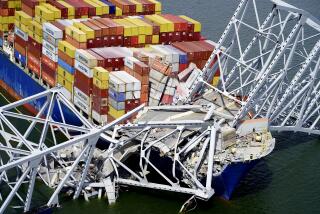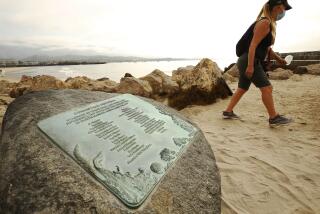OSHA Report Cites 66 Safety Violations at Navy Shipyard : Workplace: The citation arrives at the Long Beach yard just a day after it received a Navy Meritorious Unit Commendation for safety and efficiency.
LONG BEACH — The Long Beach Naval Shipyard, cited three years ago as having the most hazardous working conditions of any of the nation’s eight government yards, came under criticism again last week by federal inspectors who said they found dozens of serious health and safety violations.
According to a report filed after a three-month investigation, inspectors found 66 violations, 42 of them severe enough to result in death or serious physical harm. Some workers suffered hearing loss from deafening blasting equipment while others were exposed to possible eye injuries, burns and electrical shocks. Employees worked around open tanks of acid without rubber gloves or boots. Inspectors found cigarette butts near tanks of flammable liquid oxygen, but no signs warning against smoking or open flame, according to the report from the Occupational Safety and Health Administration of the U.S. Department of Labor.
Federal OSHA officials said the violations were serious and even life-threatening, but noted that the yard was “not one of the worst we’ve seen.”
“Any time there are serious violations, it is something OSHA considers a serious matter,” said Marsha Grueber, area director at OSHA headquarters in San Francisco. “But when you have a yard this size with 4,000 employees, this is not considered out of the ordinary as far as the number of violations are concerned.”
The report was hand-delivered to the yard just one day after the Department of the Navy presented the shipyard with a Meritorious Unit Commendation Award for excelling in safety and efficiency in the “highest traditions of the United States Naval Service.”
Jeff Gooding, director of industrial relations at the yard, said in a written statement that most of the violations already had been corrected and any remaining would be remedied by the end of the month.
The inspection conducted from Oct. 30 through Feb. 14 was the first wall-to-wall review ever performed by OSHA at the Long Beach yard and the results, Gooding said, must be viewed in perspective. A private shipyard in Maine emerged from a similar inspection with hundreds of violations and $4 million in fines, Gooding and Grueber said.
No penalties were recommended in Long Beach because it is a government-run yard and the government does not fine itself, officials said.
“Safety has been and continues to be the highest priority at the Long Beach shipyard. . . . As evidence that our efforts are successful, the lost workday accident rate has declined by 79% since 1987,” Gooding wrote.
The inspection stemmed from a complaint lodged by Jim Seay, a 39-year-old shipyard worker who says safety violations are virtually a daily occurrence at the yard on Terminal Island. Seay, a former shipyard safety inspector who works there now as a gas detection monitor, described 67 alleged hazards in his complaint. The OSHA inspection substantiated a dozen of them.
Among the most serious cited by Seay was the shipyard’s failure to provide backups when workers checked for poisonous gases in confined spaces. He said the shipyard was using workers “like canaries in a coal mine.”
Grueber said the practice was not determined to be a violation--not because it does not occur, but because regulations only require “frequent checks” rather than a buddy system. “It is not a violation of our standards,” she said.
OSHA inspectors did find, however, that confined spaces that had contained combustible or flammable liquids or gases were not tested for vapors before employees entered.
While Navy officials and some union spokesmen defend the shipyard’s safety record, Seay and others have described it as a time bomb. “The only reason we haven’t had a death at the Long Beach Naval Shipyard is we’re lucky,” Joe Walsh, a union safety official, said in an interview when OSHA’S investigation first came to light.
The shipyard received a safety rating of unsatisfactory in January, 1988--the worst rating given to any of the Navy’s eight shipyards in eight years. At that time, the naval inspector general’s staff discovered more than 500 safety violations.
Hundreds of industrial accidents had occurred at the shipyard in the years before the 1988 inspection. In two of the most serious, a worker’s right hand was crushed in a metal-bending machine and another worker lost three fingers in a punch press.
The more recent OSHA inspection revealed far fewer citations, lending credence to supervisors’ contentions that safety had improved markedly at the yard. Still, 42 of the 66 hazards cited were considered “serious.”
Among the violations noted were:
* Employees were required to perform maintenance on a holding tank without equipment to protect them from chemical and human waste. The employees had not been offered vaccinations that could have minimized their health risk.
* Mechanical power presses and table saws were not equipped with guards to protect the limbs of workers.
* There were rodents, insects and other vermin in some buildings. “Mice and rats were in the area and feces had been on the work tables,” the report said.
More to Read
Sign up for Essential California
The most important California stories and recommendations in your inbox every morning.
You may occasionally receive promotional content from the Los Angeles Times.










